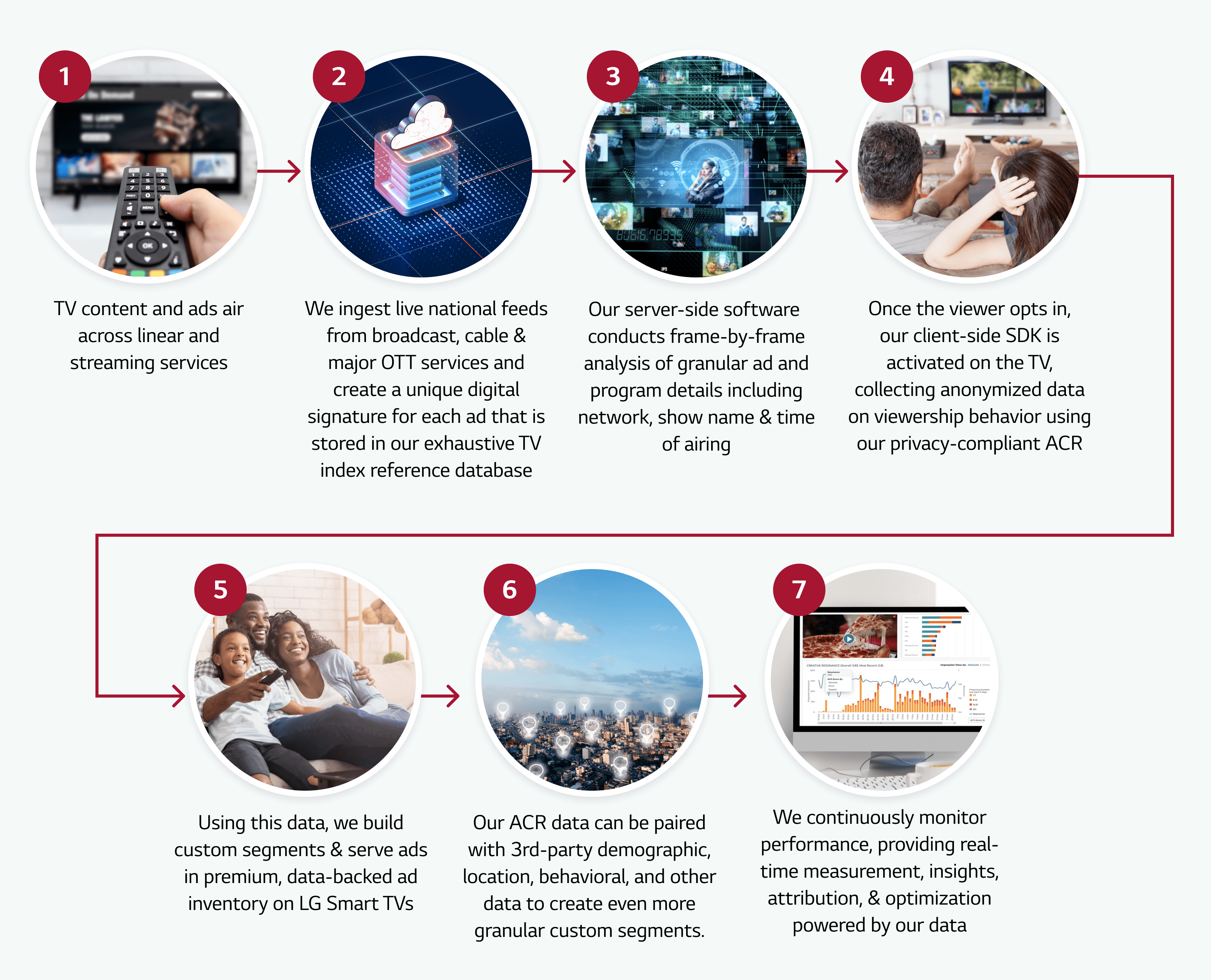With a multitude of TV viewing options available including linear TV, Subscription Video-On-Demand (SVOD), Advertising-based Video-On-Demand (AVOD), Free Ad-Supported Streaming TV (FASTs) and more, TV audiences are scattered across a plethora of apps, networks and services. How do advertisers find and reach their target audience across this fragmented landscape? App usage data is scarce, and moreover, just knowing which audience segments spend time on specific apps is not enough. Advertisers must not only place their ad in front of the relevant audience, but also ensure it occurs at the right time and place, and in the right context, where viewers are most likely to take notice. How can they achieve this level of precise targeting? Savvy marketers turn to automated content recognition (ACR).
The three biggest smart TV manufacturers, including LG, all collect their own ACR data in the U.S. – representing over 80M opted-in TV sets. ACR is a technology that provides second-by-second viewing data at massive scale. Since ACR provides “glass-level” insights – capturing all input sources, it can detect all TV viewing options and understand video games being played on the TV. It’s all done using methodologies that are consistent with federal and regional privacy regulations, with, in LG’s case, a double opt-in process by viewers.
How ACR Works

Changes in TV Viewing and Need for Precise Measurement
Historically, legacy measurement systems have used panels to model viewership behavior. Advertisers would use this data to determine where to find their target audiences across TV by analyzing what networks and platforms their target audience was most likely to spend time on. However, with today’s audiences watching programming across cable, broadcast, OTT and streaming, understanding viewership behavior is increasingly challenging, and as a ripple effect, so does reaching TV audiences with advertising. ACR data, measuring second-by-second viewing on every set enables measurement and targeting well beyond traditional systems.
Benefit To Advertisers
Smart TV OEMs use ACR technology to identify what opted-in viewers are watching in an anonymized fashion, every time they turn on their TV. This data is invaluable to advertisers. Companies like LG Ad Solutions can create audience segments based on viewership behavior, informing advertisers exactly what kind of viewer their ads can be placed in front of. Advertisers can choose from this menu of audience targets or create their own. Maybe their target audience is someone who has been binge-watching horror movies? Or maybe a viewer who prefers Spanish-language shows? Whatever it might be, ACR technology can find these viewers. Transparency and one-to-one targeting provided by ACR technology makes it easy for advertisers to find, define, and re-define their audience segments – improving campaign activation and ad measurement.
Some smart TV OEMs provide a three-fold advantage, empowering advertisers to develop data-backed strategies and get the most out of their TV buy. These three advantages involve access to:
- Ad inventory, including exclusive native units that grab the attention of the viewer from the get-go
- Owned and operated FAST channels with tons of content, providing access to granular audiences and large-scale premium video inventory
- ACR data for precise targeting and measurement to determine ROI
Partnering with smart TV OEMs allows advertisers to continually benefit from the latest advancements in TV technology, making the TV experience better not just for advertisers but also consumers.
Holistic View of TV Audiences
Access to ACR data and consequently TV audience viewing behavior, paves the way for layering on third-party datasets including demographics, geo-location, and shopping behaviors. Combining these types of data with ACR data provides us with a comprehensive viewer profile while ensuring viewer privacy. ACR not only allows companies like LG Ad Solutions to serve ads to the right audiences but also allows for measurement of ad campaign results, including video completion rates (VCR), conversions such as tune-in, app downloads, web traffic, location behavior, and even purchase.
Advertisers can also better understand the incrementality of their ad campaign, including the incremental reach gained over linear TV, over other TV OEMs and digital platforms and competitors. They can continually keep track of which audience group, message and creative, strike the best balance for highest ROI.
With ACR technology making CTV campaigns completely trackable and measurable, TV advertising has become more and more like digital. As such, it only makes sense that the digital element of pay-per-performance is brought into the world of CTV. Guaranteeing outcomes and paying only for results that meet your target metrics, which seemed impossible in the past, is a reality for CTV advertising today. LG Ad Solutions recently broke new ground in the industry by offering a suite of guaranteed outcome options, delivering guarantees on demographics, reach/frequency, VCR, and custom conversions.
To find out more about how our ACR technology can help you reach your campaign goals and measure ROAS, contact us or reach out at info@lgads.tv